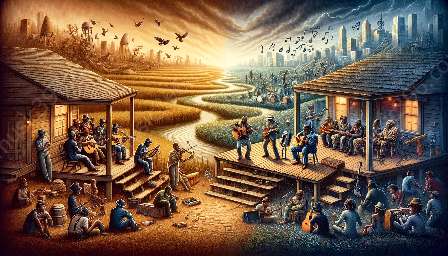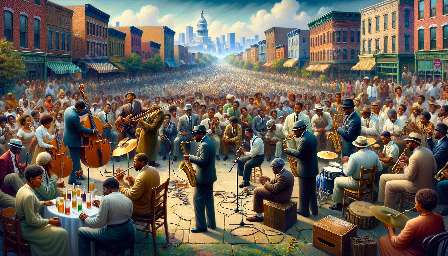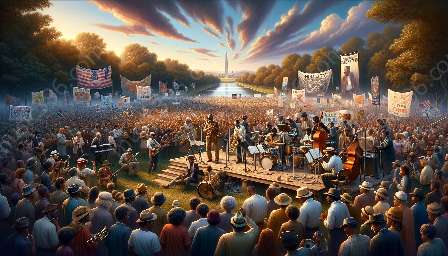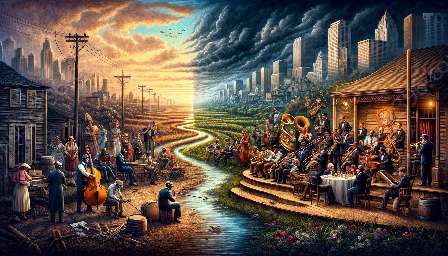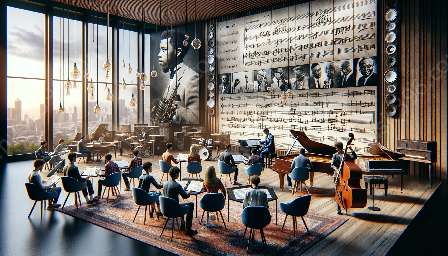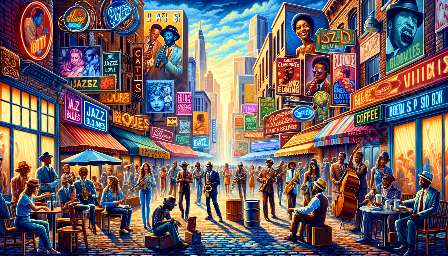The Great Migration was a pivotal event in American history, triggering significant social, cultural, and musical changes that reverberated for decades. During this period, millions of African Americans moved from the rural South to the urban North in search of better economic opportunities and escape from systemic discrimination and violence.
As they migrated, they brought with them their unique cultural heritage and musical traditions, which played a pivotal role in the development of blues music, a genre that would later influence jazz and modern blues styles. This topic cluster will delve into the interwoven narratives of The Great Migration and blues music, their evolution, and their enduring legacy.
The Great Migration: Shaping the Blues Tradition
The Great Migration, which occurred from the early 20th century to the 1970s, saw millions of African Americans leaving the Jim Crow South for the urban centers of the North, Midwest, and West. This mass movement represented a quest for economic opportunities, escape from racial segregation, and a search for political freedom.
As they settled in cities such as Chicago, Detroit, and New York, African Americans found themselves in new social and cultural landscapes. The harsh realities of urban life, coupled with the sense of displacement and longing for their southern roots, found expression in the music they created. The blues, with its raw emotion and poignant lyrics, became a powerful outlet for their experiences, reflecting the trials and tribulations of the migrants.
Blues music, rooted in African American spirituals, work songs, and folk traditions, evolved as a medium for storytelling and catharsis. Its themes of hardships, love, and resilience resonated deeply with the migrant community, providing a sense of connection and solidarity in their new urban environments. The migration served as a catalyst for the spread and popularization of blues music, as it intersected with the burgeoning recording industry and the rise of urban entertainment venues.
Evolution of Blues Music: From Delta to Urban Landscapes
The migration not only impacted the content of blues music but also influenced its musical evolution. The traditional acoustic sounds of the Delta blues merged with urban influences, giving birth to electrified, more energetic blues styles. This transformation reflected the changing experiences and aspirations of the migrants, as they adapted to city life and encountered new musical expressions.
Artists such as Muddy Waters, Howlin' Wolf, and B.B. King emerged as prominent figures in the electrified urban blues scene, shaping the genre with their electrifying performances and recordings. The migration served as a conduit for the exchange of musical ideas, as artists from different regions and backgrounds converged in urban centers, contributing to the rich tapestry of blues music.
Moreover, the migration facilitated the commercialization and dissemination of blues recordings, leading to its broader recognition and acceptance within the wider American musical landscape. The electrified blues sound not only captivated African American audiences but also captivated white audiences, influencing the emergence of rock and roll and other popular music forms in the decades to come.
The Interplay of Blues and Jazz: A Musical Fusion
While the blues was making its mark on the urban landscape, another genre, jazz, was also experiencing a transformative era. The cultural exchange brought about by The Great Migration facilitated the intersection of blues and jazz, leading to a symbiotic relationship between the two genres.
Jazz musicians, influenced by the emotive qualities and improvisational nature of blues music, began incorporating blues elements into their compositions and performances. This fusion gave rise to a distinct subgenre known as jazz blues or blues jazz, characterized by its soulful melodies, expressive solo improvisations, and syncopated rhythms.
Furthermore, the migration of blues artists and musicians to urban centers provided opportunities for collaboration and cross-pollination between the blues and jazz communities. Legendary figures such as Louis Armstrong, Duke Ellington, and Billie Holiday drew inspiration from the blues tradition, infusing their jazz repertoire with elements of blues, thereby enriching the musical vocabulary of both genres.
The Enduring Legacy: Preserving the Migrant Narrative
The impact of The Great Migration on blues music and its connection to jazz reverberates to this day, as these genres continue to influence contemporary music and culture. The migration experience, encapsulated in the lyrical and sonic tapestries of blues and jazz, serves as a testament to the resilience, creativity, and cultural heritage of the African American community.
Today, blues music stands as a testament to the enduring legacy of The Great Migration, preserving the stories and struggles of those who sought a new life in the urban North. The evolution of the blues from its rural roots to the vibrant urban soundscape mirrors the journey of the migrants, encapsulating their triumphs and tribulations.
As we explore the intertwined narratives of The Great Migration and blues music, we bear witness to a cultural resonance that transcends time and place, underscoring the profound impact of these historical forces on the musical landscape of America and beyond.


